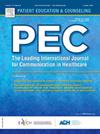中年妇女更年期特定健康素养量表的开发和验证
IF 2.9
2区 医学
Q2 PUBLIC, ENVIRONMENTAL & OCCUPATIONAL HEALTH
引用次数: 0
摘要
方法根据欧洲健康素养联盟提出的综合健康素养概念模型的四个子领域(获取、理解、评估和应用),我们结合自我报告(主观)和基于表现(客观)的测量方法,开发了 73 个初步项目。内容有效性由专家小组(14 人)评估,表面有效性由目标人群(15 人)评估。采用探索性因素分析(EFA)、确认性因素分析(CFA)、内部一致性以及基于经典测验理论和 IRT 的项目分析,对量表的效度和信度进行了评估。EFA删除了7个交叉负荷项目,得出了三个不同的因子:获取(ACS)、评价(APR)和利用(UTL)。IRT 分析显示出较高的项目区分度,其中 UTL 子域中的四个项目显示出中等程度的区分度。CFA 证实了模型的良好拟合。最终的男性健康素养问卷包括 28 个项目(6 个 ACS 项目、9 个 APR 项目和 13 个 UTL 项目),Cronbach's alpha 为 0.91。实践意义:Men-HLS 为医疗保健专业人员提供了一个实用工具,用于评估管理更年期症状和慢性疾病所需的健康素养水平,从而促进开发有针对性的教育资源和干预措施,改善健康管理。本文章由计算机程序翻译,如有差异,请以英文原文为准。
Development and validation of a menopause-specific health literacy scale for middle-aged women
Objective
This study aimed to develop and validate the Menopause-Specific Health Literacy Scale (Men-HLS) for middle-aged women aged 45–64 years, utilizing an Item Response Theory (IRT) framework and traditional factor analysis.
Methods
Based on the four subdomains (access, understand, appraise, and apply) of the integrated health literacy conceptual model proposed by the European Health Literacy Consortium, we developed 73 preliminary items, combining self-reported (subjective) and performance-based (objective) measures. Content validity was assessed by an expert panel (n = 14) and face validity was evaluated by the target population (n = 15). Validity and reliability were evaluated using exploratory factor analysis (EFA), confirmatory factor analysis (CFA), internal consistency, and item analysis based on classical test theory and IRT.
Results
The scale was refined to 45 items following content and face validity assessments and reduced to 35 items through classical test theory-based item analysis and inter-item correlation. EFA removed seven cross-loaded items, resulting in three distinct factors: accessing (ACS), appraising (APR), and utilizing (UTL). The IRT analysis demonstrated high item discrimination, with four items in the UTL subdomain showing moderate discrimination. CFA confirmed a good model fit. The final Men-HLS comprised 28 items (6 for ACS, 9 for APR, and 13 for UTL) and achieved a Cronbach’s alpha of 0.91.
Conclusions
The Men-HLS is a valid and reliable instrument for identifying health literacy challenges in middle-aged women. Further research is needed to establish its predictive validity through longitudinal data and confirm its measurement invariance across diverse sociodemographic groups.
Practice implications
The Men-HLS provides healthcare professionals with a practical tool for assessing the health literacy levels required to manage menopausal symptoms and chronic conditions, facilitating the development of targeted educational resources and interventions for improved health management.
求助全文
通过发布文献求助,成功后即可免费获取论文全文。
去求助
来源期刊

Patient Education and Counseling
医学-公共卫生、环境卫生与职业卫生
CiteScore
5.60
自引率
11.40%
发文量
384
审稿时长
46 days
期刊介绍:
Patient Education and Counseling is an interdisciplinary, international journal for patient education and health promotion researchers, managers and clinicians. The journal seeks to explore and elucidate the educational, counseling and communication models in health care. Its aim is to provide a forum for fundamental as well as applied research, and to promote the study of organizational issues involved with the delivery of patient education, counseling, health promotion services and training models in improving communication between providers and patients.
 求助内容:
求助内容: 应助结果提醒方式:
应助结果提醒方式:


